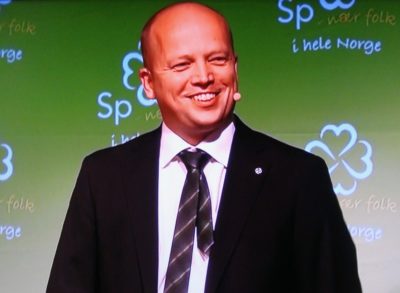“The only answer is to be radical,” declared a triumphant Lan Marie Nguyen Berg after her flourishing Greens Party trounced Norway’s established parties not only in Oslo but all over the country as well. Monday’s local elections were an exercise in humility for Labour, the Conservatives and not least the Progress Party, as protest votes handed new power to their radical rivals.

The Greens can’t entirely claim that climate issues ruled the day, since their own radical arch-rivals in the new small parties formed to battle bompenger (road tolls) did well, too. In Bergen, it was the anti-road toll party FNB that grabbed fully 19.8 percent of the vote, nearly as much as Labour’s 19.9 percent and the Conservatives’ 20.2 percent. The Greens claimed 9.8 percent in Bergen while the once-mighty Progress Party landed at just 4.7 percent. FNB also did well in Stavanger and several other communities on the West Coast, meaning they should get influence and reign in tolls.
Norway’s radical Reds Party also performed well in local elections around the country, with party leader Bjørnar Moxnes calling strong results “a breakthrough for the Reds over the whole country.” The numbers are still small, but the Reds could claim, for example, 7.2 percent of the vote in Oslo, 11.8 percent on nearby Nesodden, 8 percent in Kristiansund and as much as 17 percent in Dønna off the Helgelands coast. That will give them and the Greens much more clout as new city and county councils are formed based on election results. The Reds’ 3.8 percent on a national level was up from just 2 percent in the last elections.
Another radical party on the far right side of Norwegian politics, Demokratene (The Democrats), caused what some called “a political earthquake” when it won 13.5 percent of the vote. That may force Labour and the Conservatives to negotiate with the far-right party to form a government, unless Labour and the Conservatives decide to team up themselves. They arguably have more in common than either would have with The Democrats. Until now it’s been unthinkable for Labour and the Conservatives to cooperate but as election results showed, times are changing.
Greens won re-election for Labour
In Oslo, the strong results logged by the Greens, the Reds and the Socialist Left party (SV), which won 9 percent of the vote, will allow the Labour-led city government coalition to continue for another four years. The Conservatives remained the largest single party in Oslo, with around 25 percent of the vote, but its fellow non-socialist parties including the Liberals, the Christian Democrats and the Progress Party didn’t do well enough to unseat the so-called “Red-Green” constellation.
“There are many who are disappointed tonight,” admitted Progress Party leader Siv Jensen, who couldn’t even get her microphone to work when she had to address her crestfallen party faithful after suffering crushing defeats nationwide. Progress used to be Norway’s noisy protest party itself, but since winning national government power with the Conservatives six years ago, it’s lost its feisty grip.

The Center Party, which shared government power with Labour and teh Socialist Left from 2005 to 2013, has now emerged as Norway’s biggest protest party. On Monday it also took over Progress’ long-held position as Norway’s third-largest party, while taking over Labour’s dominance in Northern Norway as well. Center succeeded by supporting local voter protests over everything from centralization efforts to forced county mergers (not least between Finnmark and Troms) and local hospital closures. Center wound up with 15.3 percent of the vote on a nationwide basis, while Progress landed at just 8.5 percent.
Most of Norway’s other established political parties saw their long-time dominance erode. Norwegian Broadcasting (NRK) reported that the left-leaning parties collectively won 55.9 percent of the vote compared to 36 percent for the non-socialist parties. The remainder including the anti-road toll parties grabbed the other 8.1 percent.
Labour the biggest loser
Labour lost the most, falling from 33 percent nationwide in the last local elections in 2015 to just 25.1 percent on Monday. Labour repeatedly showed up as the biggest loser in one municipality after another, down 12.4 percentage points to less than 20 percent of the vote when 54 percent of all ballots were tallied.

Labour leader Jonas Gahr Støre tried to console his troops by stressing that at least Labour looked likely to hold onto power in Oslo, even though it will need to cede at least some of it to the Greens and the resurgent Socialist Left party (SV) during negotiations to form a new city government in the Norwegian capital. The Greens’ Berg has already expressed ambitions to take control of more important city government posts including those in charge of business and finance. Since SV also won more votes than in 2015, it will likely lobby for additional posts as well.
Støre admitted that Labour lost a lot of voters in Northern Norway and in outlying districts, where frustrated residents latched on to the Center Party instead. It remains to be seen whether Center will come up with solutions for local voters’ problems and complaints: “Our ambition must be to regain out position as the leading party in the Northern areas, where people are extra vulnerable to centralization and a market economy.”
Conservatives’ worst results in years
The Conservatives, meanwhile, suffered their poorest election showings in more than 40 years. The Conservatives leader and prime minister, Erna Solberg, was nonetheless the only party leader Monday night to congratulate both the Greens and the Center Party on their election victories.
Like Støre, Solberg admitted that the election results were unsatisfactory but claimed the party must carry on. “Now there will be lots of local negotiating going on,” she noted, as the parties form new town and county councils around the country through coalitions based on election results.
Solberg’s two other national government coalition partners, the Liberals and the Christian Democrats, had poor showings as well, with results of around 4 percent of the vote.

No one was more exultant over the municipal election results than the Greens’ Lan Marie Nguyen Berg. Flashing her famous huge grin she claimed that the Greens “have changed Norway forever,” and she stressed how proud she and her party fellows should be that they not only doubled their election results but actually won re-election. Given all the loud protests in Oslo over how her party has pushed the city goverment into removing street parking, boosting road tolls and closing entire streets to discourage driving in the capital, it’s remarkable the Greens did so well.
Berg claims it’s all because “this year’s election was a climate election.” She chided “outdated politicians” who haven’t taken climate issues seriously enough or paid attention to voters’ demands for emissions cuts and efforts to stop climate change. The Greens also did well in many other places around Norway, from Vardø in the far north, where they won 22.4 percent of the vote, to Trondheim (10.3 percent) and Bergen (9.8 percent).
Berg, like most other party officials, was already looking ahead to the next Parliamentary election in 2021, when they’d also promise “hard environmental policies” as their “green wave” rolls over the entire country and may gain much more influence on oil and gas policy.
newsinenglish.no/Nina Berglund

